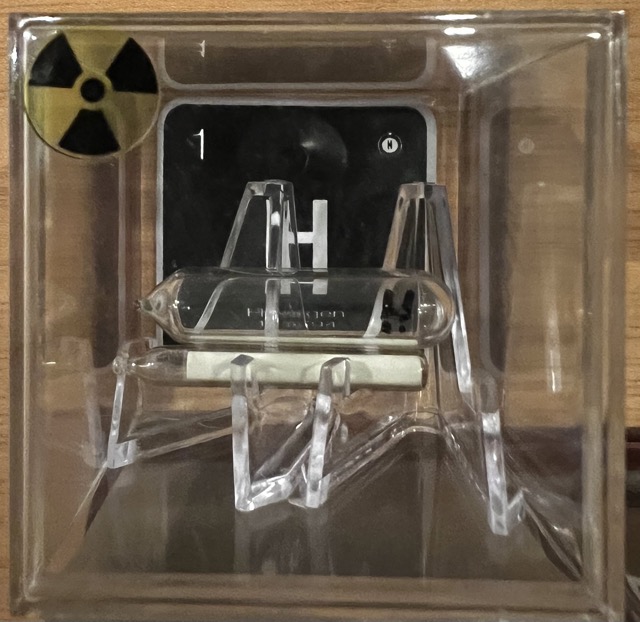Hydrogen from the periodic table of elements is one of the most fundamental and fascinating substances in the universe. It is the lightest and most abundant element, playing a critical role in both the formation of the cosmos and the technology that powers our modern world. From fueling stars to enabling clean energy solutions on Earth, hydrogen’s versatility and importance cannot be overstated.

Hydrogen
Atomic Number: 1
Atomic Mass: 1.00784 u
Find out why there is a radioactive symbol on the Hydrogen case.
Discovery of Hydrogen from the Periodic Table
The discovery of hydrogen dates back to the late 18th century. In 1766, English scientist Henry Cavendish was the first to recognize hydrogen as a distinct element. While experimenting in London, he discovered that a colorless, flammable gas was produced when metals reacted with acids. He referred to this gas as “inflammable air.” When Cavendish later burned this gas and observed that it produced water, he realized hydrogen (from the Greek words “hydro” and “genes,” meaning “water-forming”) was an essential component in water itself.
Although Cavendish is credited with isolating hydrogen from the periodic table of elements, it was Antoine Lavoisier, a French chemist, who named the element “hydrogen” in 1783. Lavoisier’s work on the composition of water solidified our understanding of hydrogen’s role in chemical reactions and its place among the building blocks of matter.
Hydrogen’s Role in the Universe
Hydrogen from the periodic table of elements is not only the simplest element, consisting of just one proton and one electron, but it also serves as the foundation for all other elements. In the core of stars, hydrogen atoms undergo nuclear fusion, combining to form helium and releasing vast amounts of energy in the process. This reaction is what powers our sun and fuels the stars scattered across the night sky.
Modern Day Uses of Hydrogen
Today, hydrogen from the periodic table of elements has found applications across numerous fields, particularly in energy, industry, and technology. With growing concerns about climate change and the need for clean energy alternatives, hydrogen is being viewed as a crucial component of the future energy landscape.
Clean Energy and Fuel Cells
Hydrogen is at the forefront of clean energy innovation. Hydrogen fuel cells are being developed to power everything from cars and buses to buildings. When hydrogen reacts with oxygen in a fuel cell, it produces electricity, heat, and water as the only byproduct—making it an eco-friendly alternative to fossil fuels. Hydrogen-powered vehicles, often referred to as fuel cell electric vehicles (FCEVs), offer the potential for emission-free transportation.
Industrial Applications
In the industrial sector, hydrogen is used in processes like refining petroleum, producing ammonia for fertilizers, and processing metals. The chemical industry relies on hydrogen from the periodic table of elements as a crucial reagent for producing many important compounds. For example, ammonia production through the Haber-Bosch process is essential for global agriculture and food production.
Rocket Fuel
Hydrogen is also a key component in space exploration. In its liquid form, hydrogen serves as a powerful rocket propellant. When combined with liquid oxygen, it generates the thrust necessary to propel spacecraft beyond Earth’s atmosphere. NASA has been using hydrogen-based rocket fuel since the 1960s, making hydrogen critical to space missions and technological advancements in space exploration.
Energy Storage
Hydrogen is also being explored as a means of energy storage. Renewable energy sources like solar and wind are intermittent, generating electricity only when the sun shines or the wind blows. Excess electricity produced during peak times can be used to produce hydrogen through electrolysis (splitting water into hydrogen and oxygen). This hydrogen can then be stored and later used to generate electricity when demand is high, offering a solution to the problem of energy storage.
The Future of Hydrogen
As the world continues to transition toward renewable energy and sustainable technologies, hydrogen from the periodic table of elements will play an increasingly important role. From hydrogen-powered transportation to industrial applications and space exploration, this versatile element offers numerous possibilities for reducing our dependence on carbon-intensive fuels and creating a cleaner, more sustainable future.
In conclusion, hydrogen’s journey from its discovery in a London laboratory to its modern-day applications highlights its significance both in the natural world and in human innovation. As we continue to explore new uses for hydrogen from the periodic table of elements, this simple yet powerful substance remains key to shaping the future of energy and technology.
 using WordPress and
using WordPress and
Comments are closed